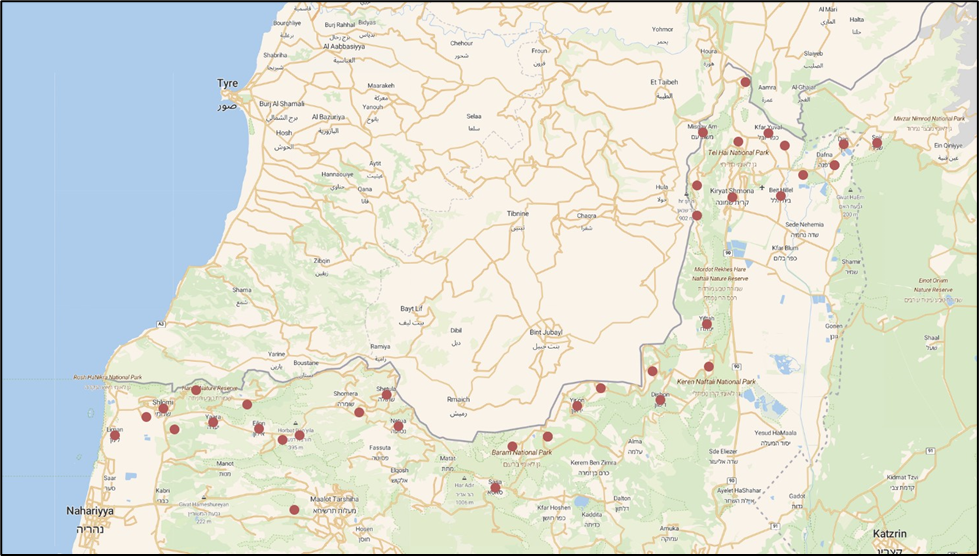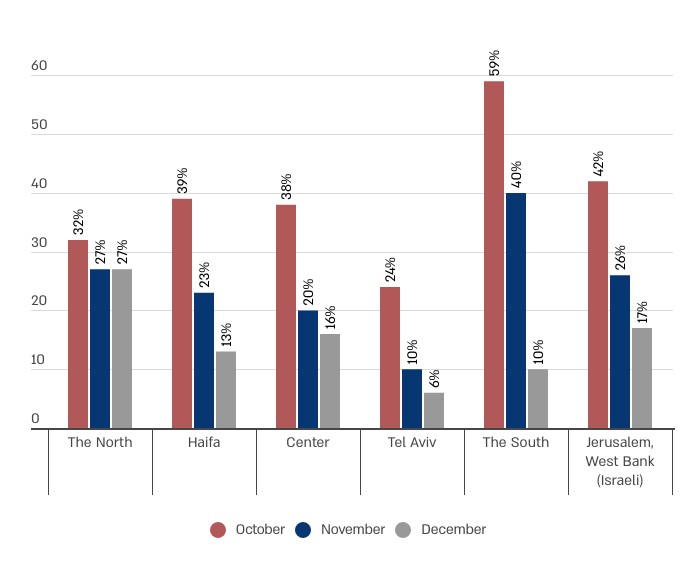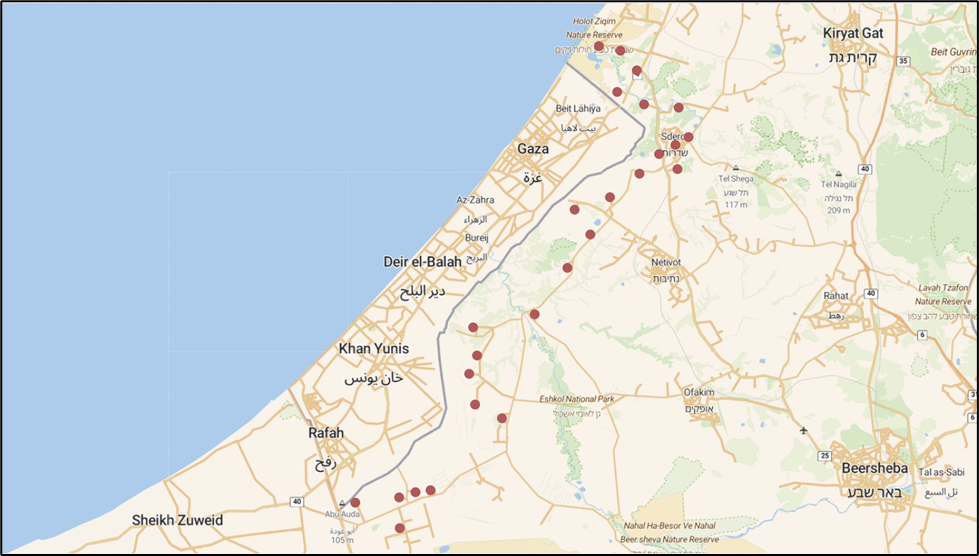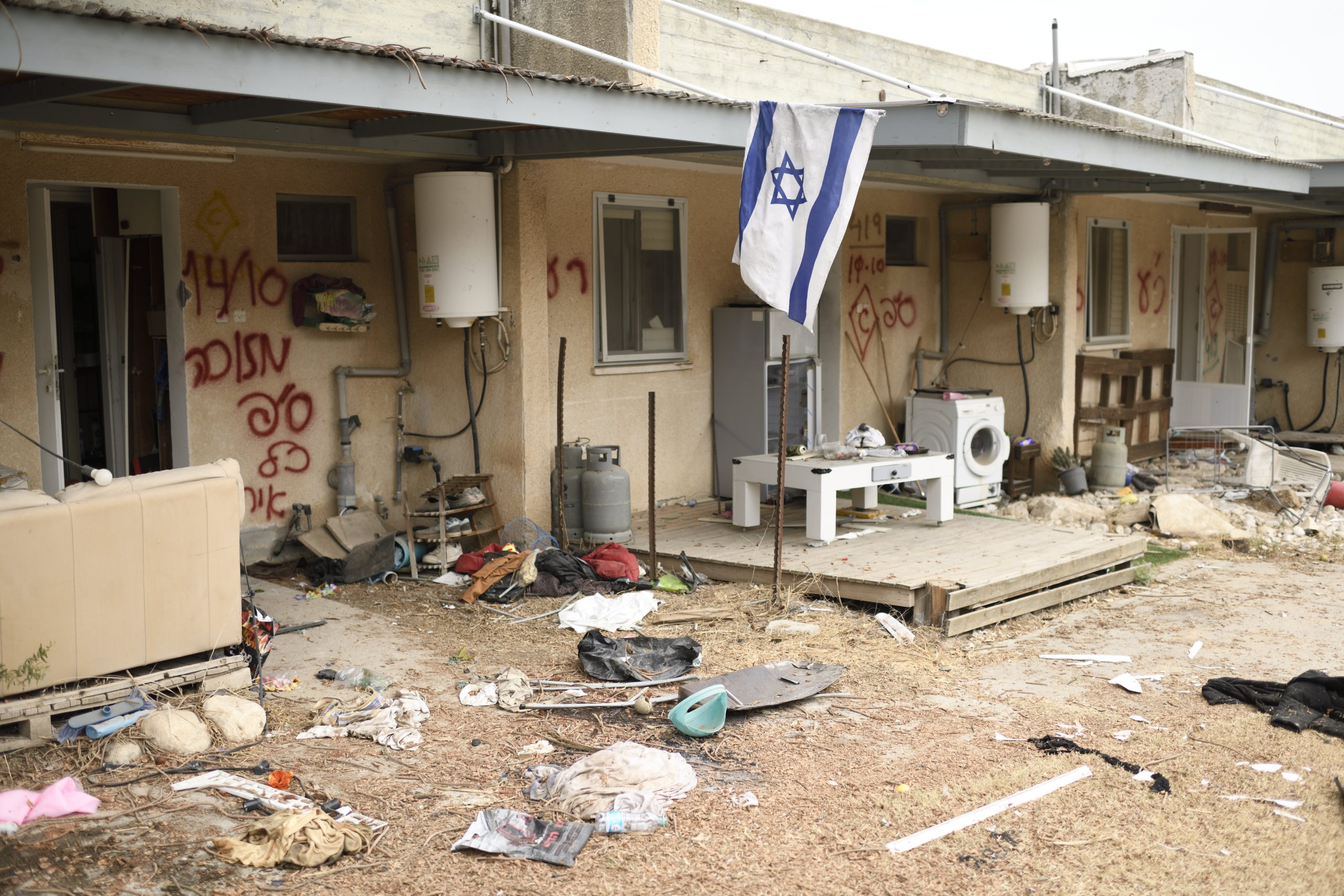Publications
Special Publication, February 21, 2024
Resilience is the ability of any system to successfully manage a serious disruption, limit the damage and functional setbacks, bounce back quickly, move forward, and achieve improved functionality. The tragic events of October 7 and the resulting two-front war certainly constitute a serious disruption that is testing the resilience of Israeli society in general, and of the communities evacuated from their homes in the western Negev and the northern border in particular. The evacuations, although deemed necessary for security, exacerbated the degree of the disruption—in addition to the complex challenge of rescuing the kidnapped hostages—and devastated the functional continuity of these frontier communities. Recently we have witnessed the initial steps of restoring some degree of normalcy among some of the southern communities, whether by moving displaced residents to temporary housing in other localities or by returning some to their homes in the western Negev. These processes could signal the beginning of recovery. However, they must be managed wisely—in concert with the evacuees, the communities, and their representatives—to move from functional degradation to overall recovery and renewed growth. Bridging the gap between the expectations of the evacuees and the demands of the local authorities, along with the uncertain level of flexibility and sensitivity of the government, presents a significant challenge. Although the success of this process is not guaranteed, it is essential at both the local and national levels, as the rehabilitation and renewed growth of these border localities will symbolize Israel’s real victory over Hamas and Hezbollah.
Since October 7, according to data from the National Emergency Management Authority, some 126,000 residents from the western Negev along the Lebanese border have been officially evacuated from their homes. Many others left their homes at their own initiative and expense for various periods of time. The total number of evacuees, according to official sources, amounts to about 218,000 displaced citizens. At the beginning of the war, most of those displaced by the government decree were accommodated in hotels. As of January 21, figures of the Ministry of Tourism show that 47,700 remain in hotels and another 55,400 evacuees are housed in various communities and rental accommodations. In addition, more than 10,000 residents from the north and the south, who left their homes on their free will, have relocated to places far from the front lines.
This unprecedented situation, both in terms its extensive scale and prolonged duration, amid acute security threats, has significantly eroded the residents’ sense of safety and has caused them to lose faith in the military and government. The government’s decision to evacuate border areas due to security concerns, marking a departure from previous policies, has led to the expectation among the displaced residents that the threats would be completely removed before their return home. These circumstances present serious challenges in a variety of issues, from the national significance of the border communities as a vital component of Israel’s national security to practical considerations relating to the conditions under which the evacuees can return. These challenges have profound implications for the concept of Israeli resilience, which is predicated on the ability to recover and move beyond the events of October 7, the ongoing war, and their resultant disruptions.
Following the evacuations and, particularly, after four months of war, some of the displaced evacuees and government agencies have begun taking tentative steps toward reestablishing a semblance of normalcy. This effort to maintain some level of functional continuity in various forms is evident in the following data, which also illustrates the complexity of the situation:
Evacuees from the north: As of December 26, 2023, some 61,800 residents along the northern border were officially displaced from 61 towns and villages (see Figure 1). They include 27,000 residents of the villages closest to the border, who have been officially displaced since October 18; some 23,000 residents of the town of Kiryat Shmona, who were officially evacuated starting October 20; and another 11,000 residents from villages located up to 2.5 miles from the border. In addition, approximately 15,000 people voluntarily left their homes. Currently, most of those officially displaced are still accommodated as families in about 200 hotels across the country, facing considerable uncertainty about their future due to the security situation and the possibility of a wider war in the north. As of mid-January, there were unofficial reports about the possibility of allowing residents to return to localities that are at least 2.5 miles from the border, although the security situation remains precarious, and strict guidelines are in place concerning the movement of civilians near the border.

In general, local municipal leaders and the evacuees themselves have stated that discussions about returning to their homes is premature without significantly diminishing the military threat from Hezbollah, particularly the retreat of its Radwan Force beyond the Litani River. Under these conditions, this group of evacuees is not expected to begin bouncing back anytime soon, as most are likely to remain in temporary accommodations for an indefinite period, far from their homes and places of work. This population segment faces socioeconomic challenges greater than the national average and the evacuees from the south. A survey of businesses conducted by the Central Bureau of Statistics indicates that since the start of the war, the rate of businesses reporting low employment (minimum activity or temporary closure) in the northern region has remained relatively high and unchanged, despite signs of economic improvement in the country, including the southern region (see Figure 2). A study assessing the mental, economic, and communal situation of northern residents since the start of the war also shows a considerable decline in these areas. Notably, the study indicates that 50 percent of the residents evacuated from the north stated that their ability to work had been impaired, and that residents of eastern Galilee (including the town of Kiryat Shmona) are experiencing posttraumatic stress at three times the pre-October 7 level. Additionally, 43 percent of the evacuees stated that their personal relationships and social life had been adversely affected by the situation.

Evacuees from the western Negev localities within 0–2.7 miles from the border: This group experienced the highest rate of murder and destruction by Hamas in its October 7 attack. They were all evacuated to hotels by the state, mainly based on their community affiliation. This group is relatively strong, economically and socially. Currently, they are unable to return home due to security concerns and damaged infrastructure. Under the auspices of Tkuma (the state agency established after the war started to rehabilitate the Gaza perimeter), some members of this group, particularly those from rural communities, are in the process of moving to temporary residential sites in host communities selected by the displaced communities. This move signifies a positive step forward in ensuring functional continuity. It replaces the challenges of residing in hotels with temporary homes in locations that will provide a better semblance of normal family and community life. This transition involves dialogue both between and within the communities, reflecting their choices and preferences and strengthening their personal and social resilience. Simultaneously, some economic activities have resumed in the western Negev localities, such as Beeri Printers, which returned to operation just a few days after October 7 and agricultural work, alongside the beginning of reconstruction of damaged sites. All this underscores a strong desire of most displaced residents of these communities to return home as soon as possible, considering the pace of reconstruction and the security situation.
Western Negev evacuees from localities within 2.7–4.5 miles from the border: This group consists of roughly 38,000 displaced residents, mostly from Sderot (not including larger towns such as Netivot and Ofakim). Since early January, there have been initial reports that the IDF is prepared for the return of some displaced residents to several localities. The military drew up a plan for improved security, depending on the proximity to the Gaza Strip and the specific security needs, ensuring that each locality is provided with a customized defensive package. This would include the reinforcement of on-call squads with weapons and other means, such as electronic fences and cameras. The budget for these measures, estimated at ILS 650 million ($180 million), of which some ILS 400 million ($110 million) would be provided by Tkuma, is designated for immediate use by the villages in this area and the town of Sderot. At the same time, public services, including transport and health, have been restored. As a result, some of these localities have already been fully or partly repopulated. It should be noted that unlike the north, where Hezbollah’s offensive capabilities remain virtually intact, the IDF has severely diminished Hamas’s offensive capabilities in the south.

On January 7, the Ministry of Education and the Tkuma administration announced a plan for pupils from Sderot and Sha’ar Hanegev Regional Council to return to school in February (later postponed to March) and enable families to return to their homes. However, this plan sparked disagreement between the government, aiming for a swift return of the residents, the local authorities, and the residents themselves, who have demanded that security and economic improvements be incorporated into the government’s plan.
The efforts of state agencies, including the IDF, Tkuma, and the Ministry of Education, to return the residents to their homes have been met with strong criticism. Both residents and local authorities claim that decisions are being made without consulting them. They argue that the proposed plans do not effectively address their security concerns nor provide a satisfactory solution to their basic educational and economic needs in the short and long term. While Tkuma is involved in an ongoing dialogue with the displaced residents and their representatives, the community’s overall sentiment is that they feel that the government’s decisions do not fully acknowledge or meet their concerns and needs.
The Dilemmas Surrounding the Displaced Evacuees
The challenges faced by the displaced evacuees and the fate of the kidnapped hostages present an array of unprecedented dilemmas for decision-makers. The scope and duration of the evacuations, even without a war against Hezbollah in the north, which would severely exacerbate the situation, create major dilemmas on both fundamental and practical levels. At the core of these issues is the acknowledgment that the state has completely failed in its primary duty to protect the residents of the border communities. This duty is paramount and integral to Israel’s security concept since the early days of the Zionist project, which has considered the border communities as a crucial component of the state’s security. The current war has at once led to the questioning of the validity of this convention. Clearly, both the Zionist ethos and the security requirements not only justify the return of the evacuees to their homes as soon as possible but also oblige the state to find ways to fully rehabilitate the affected communities to ensure their long-term security, stability, and growth. The more thorough, orderly, and successful this process is, the more it will contribute to the national resilience, constituting a victorious response to Israel’s foes. Also, long-term evacuations on two fronts will significantly tarnish Israel’s image of deterrence, giving its adversaries grounds to claim that they have succeeded in undermining Israel’s fundamental settlement policy. Internally, displacement of this scale will serve as a painful reminder of the severity of the challenges Israel faces and the difficulty in recovering from such a crisis.
The lengthy absence of residents from their communities, their homes, and their daily routine negatively affects their personal and communal functioning and resilience. This impact is particularly acute if there are no signs of a return on the horizon, and as long as evacuees are housed in hotels. Although the physical conditions of these accommodations may be largely acceptable and are appreciated, there have been consistent reports of severe mental stress among the displaced families. For example, in the Eshkol Regional Council, based on a local survey, about 40 percent of the families who were evacuated from the same communities have been separated and are currently living in different locations. Additionally, the distance from their original homes has made it difficult for some evacuees to retain their employment, causing financial strain. Furthermore, some displaced youngsters are struggling to keep up with their school routine, and consequently are engaging in negative behaviors.
The concerns of the displaced residents and the local authorities are understandable. In both the south and the north, the conflict continues, including direct and indirect fire and the threat of terrorist infiltration. The claims of the displaced civilians that they are not sufficiently involved in the decisions over their fate reflect their deep lack of trust in the state and the military authorities, amplifying their worries over the deep gaps between the solutions proposed by the state and their perceived security and financial needs.
In this context, there is a growing disagreement between the different parties involved in addressing this delicate situation—among the evacuees, who differ among themselves on how they perceive their needs and present their positions; between the residents and their local authorities; and between the municipal leaders and the Tkuma administration in the southern region and the government. Significant tension exists between these groups, exacerbated by the skepticism of some evacuees in realizing their expectations in the future.
Conclusions and Recommendations
Until all the evacuees can return home and resume their routine activities, the mass evacuations—alongside the hostage crisis—will remain a festering wound affecting Israel’s morale. However, any step, no matter how partial and temporary, taken toward resuming normal life is a positive and important advancement in the process of recovering and bouncing back. It marks a transition from severe disruption toward recovery—albeit slow and gradual—within the framework of national, communal, and individual resilience. This process of recovery varies in nature, speed, and substance among the different families and communities.
Although mass displacement is primarily a personal and communal challenge, the responsibility of addressing falls largely on the government, which is expected to lead significant and profound processes to restore normalcy. Rehabilitating the border communities in the south and the north is a key national interest, particularly after the events of October 7. However, the government cannot manage this sensitive process alone. It is crucial to establish a clear and organized policy that caters to the diverse needs of each group and community. This policy must recognize the sensitivity and complexity of the task, providing flexible and comprehensive support for the needs and demands of the residents and their representatives, especially those requiring financial assistance.
Fundamental for any progress in the return and rehabilitation process is the systemic and consistent management of the security challenges and handling the residents’ concerns and anxieties following the traumatic events of October 7. Given the personal and collective trauma experienced at the start of the war and then during the mass displacement, the evacuees expect maximum security for the long term. While this expectation is valid and natural, it is also ambitious and is impossible to fully guarantee. The solutions depend not only on the IDF’s establishing of a security perimeter but also on developments across the border and the arrangements reached by the parties. The gap between the residents’ expectations and the security provisions that the IDF can provide is significant. The uncertainty surrounding the political-security arrangements for “the day after” the war complicates these challenges. Consequently, the process of returning the residents necessitates continuous dialogue with them and their representatives, rooted in understanding and catering to their fears and needs through transparent and trustworthy communication. It also requires a clear and improved concept of security post-October 7, encompassing tangible security measures and addressing the aspect of perception, which is strongly shaped by the resonating memory of that “Black Sabbath.”
A comprehensive strategy is necessary to shift the responsibility of implementing the plans related to civilian matters, including the evacuees’ return, from the national government to the local authorities. In the current situation, the reliance on the state involvement in these issues is too great. The government, its ministries, and its agencies set up during the war to handle civilian matters are facing obstacles in managing themselves and in delivering complete and suitable responses to the residents’ expectations. Local authorities must be given wider leeway to manage the processes of return and rehabilitation.
Restoring the settlement in the border areas must include the full involvement of the residents via their representatives in the decision-making process. Addressing the frequent allegations that this is not happening and that any discussion with the residents is just lip service is important practically and symbolically. Cooperation should empower the residents, give them the utmost control over their future, and help to restore their faith in state institutions and the IDF. Implementing this is challenging, however, due to the residents’ understandable lack of trust in the government.
The return of the evacuees to their communities should not be perceived as an end but rather as an important stage in a complex, costly, and long-term process. This process aims to restore and even enhance the full functionality and growth of these communities and strategic regions, to a higher standard than before October 7. Even prior to the war, the quality of life in Israel’s southern and northern periphery lagged by many measures. The conflict should be an opportunity for material improvements and should guide all plans for the return of the evacuees to their homes.
The government should offer an integrated concept of security, economic, and social perimeters to the residents of both the north and south, with their maximum involvement in the planning and execution. This process should go beyond constructing a suitable defense perimeter and should also focus on establishing economic and social perimeters for the long term. A well integrated security, economic, and social framework will ensure full recovery, fostering communal and regional growth. This national mission—as crucial as the return of the hostages—will showcase the prosperity and security of Israel’s border areas, symbolizing the real victory over Hamas and Hezbollah.



